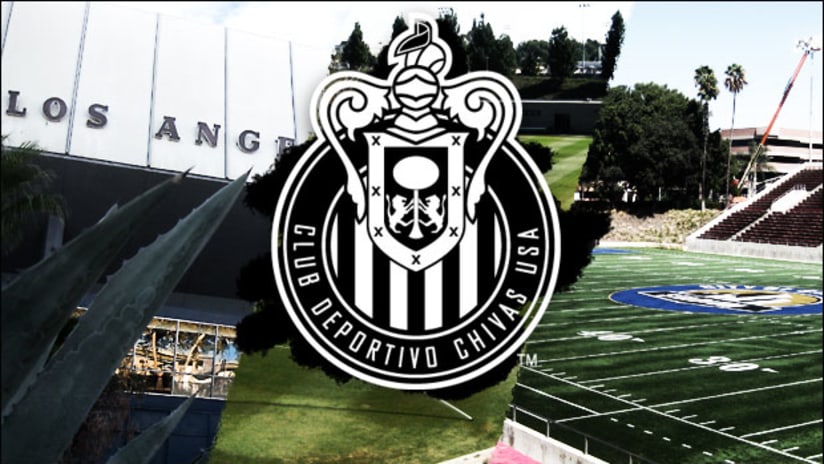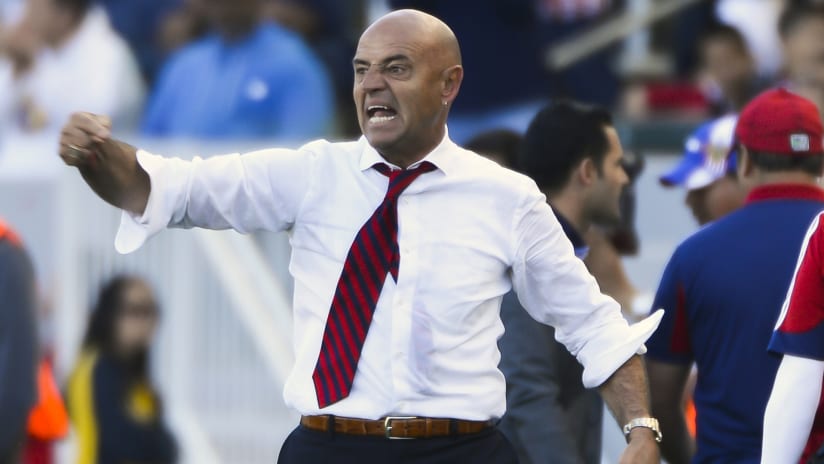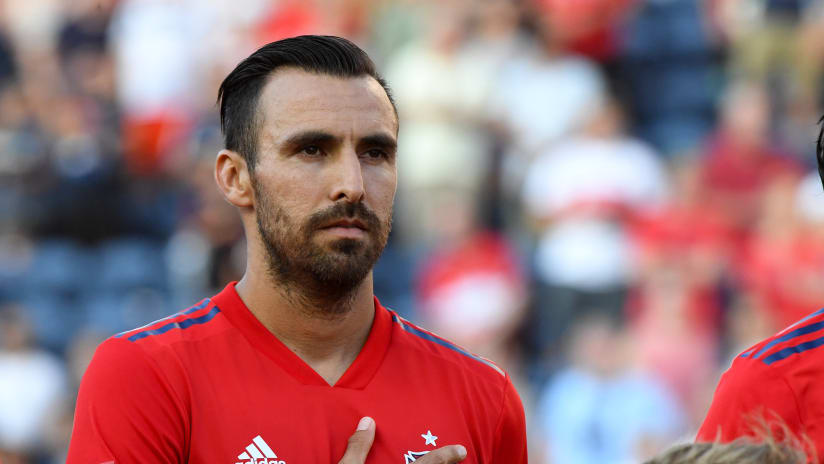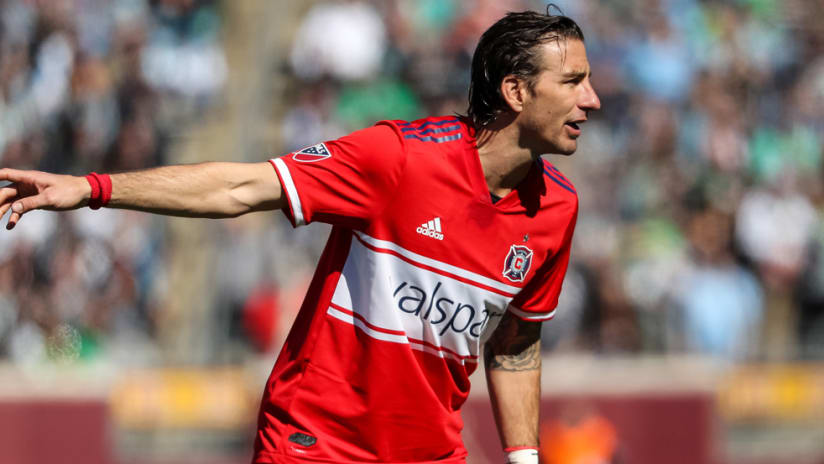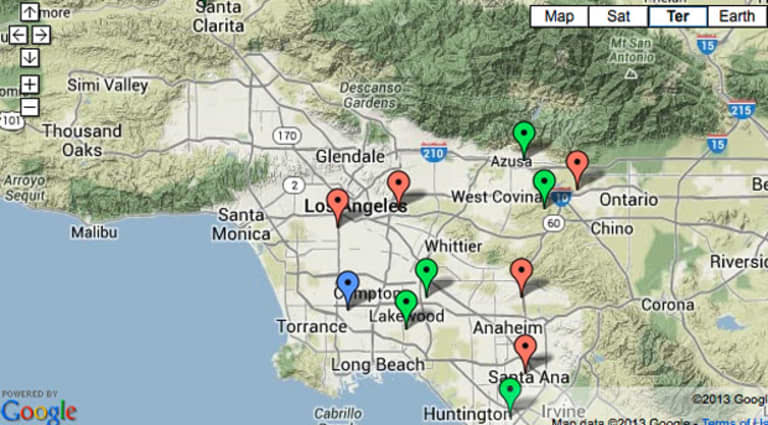
THE WORD is MLSsoccer.com's regular long-form series focusing on the biggest topics and most intriguing personalities in North American soccer. This week, LA Galaxy beat writerScott French goes across the hall at the StubHub Center to examine what the future could bring for Chivas USA in their search for a new home in Los Angeles, all the way from Exposition Park to the far eastern suburb of Pomona. Click the image above or here to view the locations in more detail.
LOS ANGELES – Chivas USA have long desired a home of their own, and with their lease agreement to play at the StubHub Center expiring following the 2014 season, they need to do something about it.
They've been looking around for a good five or six years now, surveying possibilities in and around Los Angeles, and if there isn't a hard deadline to make a decision of some sort, a soft deadline is soon approaching.
Club management would like to have a more clear idea of things before the end of the year, but options are limited and somewhat complicated. They range from a chance at a new stadium adjacent to the iconic Los Angeles Memorial Coliseum all the way to the eastern suburb of Pomona, where there’s land potentially for the taking, but no stadium in site.
They've looked intently at five sites in their search for a new home, but it’s not yet clear which site presents the best, most realistic option, or if an even better location might present itself for a short or long-term solution.
“We do need to look at different options, and that's what we're doing actively right now,” Dennis te Kloese, the sporting president of Chivas USA and mother club Club Deportivo Guadalajara, told MLSsoccer.com. “To predict something on where we are after this season and, most important, after next season is still a little bit up in the air.
“We're actively looking at different options, looking into what's best for our ownership, best for our team, and best for our family.”
---
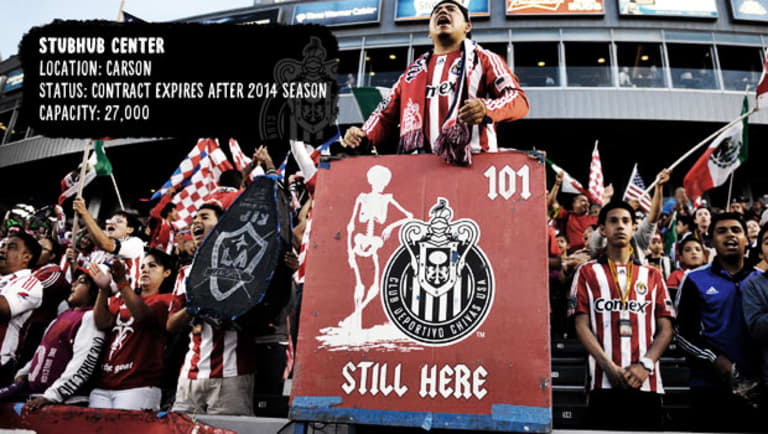
(USA Today Sports)
---
Not enough has gone right for Chivas USA since they arrived in MLS for the 2005 season, under the ownership of CD Guadalajara owner Jorge Vergara and his initial partner, Antonio Cué.
Branding went somehwhat awry – the Chivas moniker didn't move the huge SoCal fan bases of Club América, Monarcas Morelia, Pumas UNAM, Cruz Azul, Santos Laguna and other Guadalajara rivals – and the roster, heavy on second-division Mexican players and with only aging winger Ramón Ramírez a recognizable star, didn't entice the many here who root for Guadalajara.
Worse, Chivas USA failed to deliver on one of their initial promises: to bring a Mexican brand of soccer to the US professional game. They finished 4-22-6 in their first season, and a portion of their potential audience tuned out. But they came back the next season as the club enjoyed success in following years, including a first-place finish in the Western Conference in 2007 and four straight playoff appearances, under Bob Bradley and then Preki (and with Mexican legends Claudio Suárez and Francisco “Paco” Palencia in tow).
Attendance was more than reasonable, too, with a reported 19,840 fans per game in 2006, good for second-best in the league, and then roughly 13,000-15,000 per game in the seasons to follow.
But the club has since fallen on hard times. They have not made the playoffs since 2009, attendance is down this season to 8,200 per game, and they're languishing in last place in the West. And some fans’ antipathy to the Vergara, who last year bought out Cué and declared the club was seeking to return to its Mexican roots, hasn't helped.
Neither does playing in the shadow of the LA Galaxy, one of MLS's signature franchises and Chivas USA's in-house rivals. The two sides will square off this Sunday in the latest edition of the SuperClasico, but most of the spotlight will be on the Galaxy, who have won the last two MLS Cup titles and boast such big-name stars as Landon Donovan and Robbie Keane.
Technically, Chivas USA will be the away team on Sunday at StubHub Center. But in a sense, they are always the away team there. The 27,000-seat stadium in Carson is operated by Galaxy owner AEG. It is very clearly the Galaxy's home, while the Goats are merely tenants.
“I think for every team, it needs to feel like home,” te Kloese said. “It needs to feel like the team is really defending its home.”
Te Kloese, a former Chivas USA technical director whom Vergara brought in last December, has led Chivas' stadium search since coming on board, and he says with the arrival last month of new team president Arturo Gálvez, “the process will speed up a little bit.”
The club has wanted a new home almost from the moment they began play in MLS, and much of it has to do with demographics. Carson is located in Los Angeles's South Bay region, far from the epicenter of Chivas's target fanbase. Greater Los Angeles is home to nearly 17 million people, roughly 40 percent of them are Hispanic, and the vast majority of those have Mexican roots. This is Chivas' target audience.
That mandates proximity – and simple public-transportation options, te Kloese says – to the traditional Mexican communities in East LA, those surrounding downtown Los Angeles, and those south of downtown. This is where the club would like to be.
---
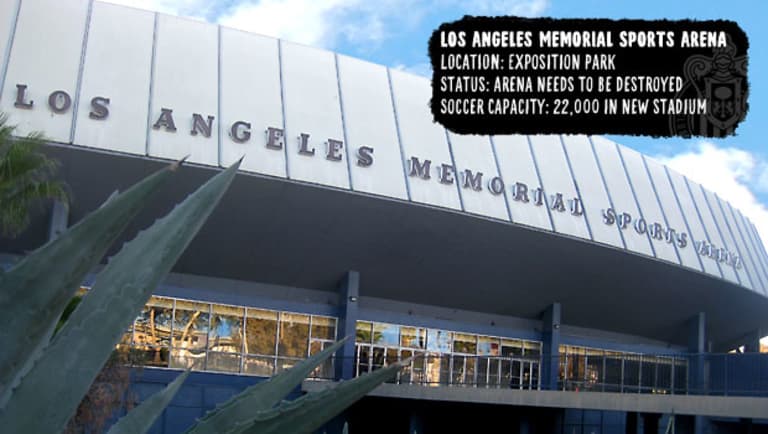
(Photo by Scott French)
---
The most highly publicized option is in Exposition Park, immediately south of the campus at the University of Southern California. Chivas USA and Major League Soccer have engaged in sporadic talks over several years with USC about potentially building a 22,000-seat stadium on the site of the Los Angeles Memorial Sports Arena, which sits next to the Coliseum.
That move was all contingent upon USC taking control of both publicly owned facilities, and final approval for that arrived in early September.
USC officials have not decided what they will do with the Sports Arena property, and it could be some time before they do so. It appears that the Coliseum itself is not a likely short-term option for Chivas USA and is certainly an unlikely answer for the long run – even though it has hosted international soccer exhibtions in the past. It's unclear how long the team wants to wait for the Sports Arena project to be completed.
“I think the talks have been going on for a while now, and I think we should be very open to that,” te Kloese said. “I think we should take into account every possibility for us to take benefit of all the options and anything that can offer anything positive to our franchise, and one of the options is [the Sports Arena site].”
At issue is how soon the site could be ready, and if USC decides to build a stadium at all. The university has been angling for years for control of the Coliseum and Sports Arena and finally took over operations in July, shortly after the governing board of the California Science Center – Los Angeles' science museum, also located in Exposition Park – unanimously authorized the final piece of a 98-year lease agreement last month.
USC's first priority is to refurbish the 90-year-old, 93,607-seat Coliseum, the centerpiece of two Olympic games, former home to two NFL teams and now the Trojans' football home. The lease deal mandates that the university spend up to $100 million on improvements.
Plans for the Sports Arena – a 54-year-old venue that was at different times in the past home to the NBA's Lakers and Clippers but also outlived its usefulness a while ago – haven't been finalized. The Coliseum Commission, the previous managers, in 2010 presented a draft environmental impact report that suggested two potential replacements: the 22,000-seat stadium and an amphitheater. USC could choose something else, too.
“You won't notice a lot [of work in the complex] this year, because we just got control of it,” USC athletic director Pat Haden told ESPN Los Angeles last month. “There will be a few cosmetic things. ... Over the next year or so, we've got to develop a plan and a fundraising plan for what it's going to look like, but I don't think anything major is going to be taking place for another two years.”
The proposed stadium would be designed to be shared by an MLS club and USC's women's soccer and women's lacrosse teams. It also could stage concerts and high school football games and would be an alternative to the Coliseum for international and club soccer matches.
Vergara, always adamant that the club will remain in Los Angeles, said last November that he planned to reopen talks with USC. Both USC and Major League Soccer officials declined comment for this article when contacted by MLSsoccer.com, but MLS Commissioner Don Garber has voiced his support of the move in the past.
“The league gets very engaged with all of our clubs in stadium development and, by the way, we're pretty good at it,” Garber said last November. “We've been working for the last year or so on a project here, we're going to continue now that [Chivas] ownership has been finalized and try to get that stadium back on track. It certainly was delayed for many, many months. We'll give them a call and hope they're still interested.”
---

(Photo by Scott French)
---
Chivas USA, however, also have interest elsewhere.
East LA College's Weingart Stadium is in Monterey Park, and borders Unincorporated East Los Angeles, which in the 2010 US Census boasted 120,000 residents of Hispanic/Latino ethincity, 97 percent of the area's population.
Like the StubHub Center, it is easily accessible via three major freeways – with a fourth, the northwest-southeast spine Santa Ana Freeway, also nearby – and the school, a community college, recently built a parking structure near the venue to alleviate the traffic crunch.
The stadium, built in 1951 and refurbished in 1984 for the field hockey competition at the Los Angeles Olympics, holds 20,355 in all-bench seating, but the field is artificial turf surrounded by a running track that limits width. The press box and locker rooms would require ample rennovation.
“I think we're open to it,” said East LA men's soccer coach Eddie Flores, who has been involved in preliminary talks with Chivas USA. “But until they finally decide to sit down and talk to the college, nothing's really happening."
Vergara, te Kloese and Palencia, the former Chivas player who is now the club's director of soccer, have all toured Weingart during their search.
“I think first of all, the location is one of the positives,” te Kloese said. “I think to make it an MLS facility, there obviously needs to be some remodeling. But if you're looking at a house to rent for your family, there are things that you look at: The location, the style of the house, but you need to look a little bit further also, with the vision of making with maybe some remodeling.”
Said Flores: “We could have the stadium renovated for probably $50 million. I think that's a bargain, but I'm not shilling out the $50 million.”
Before construction could begin, the usual paperwork – environmental impact reports, architectural plans, agreements on financing, etc. – would have to be approved. And the school is state property, so there's added bureaucracy to negotiate.
“The logistics are going to be tough, because it's a public entity ...” Flores said. “The dynamics when they built [StubHub] Center, those dynamics probably exist here.”
---
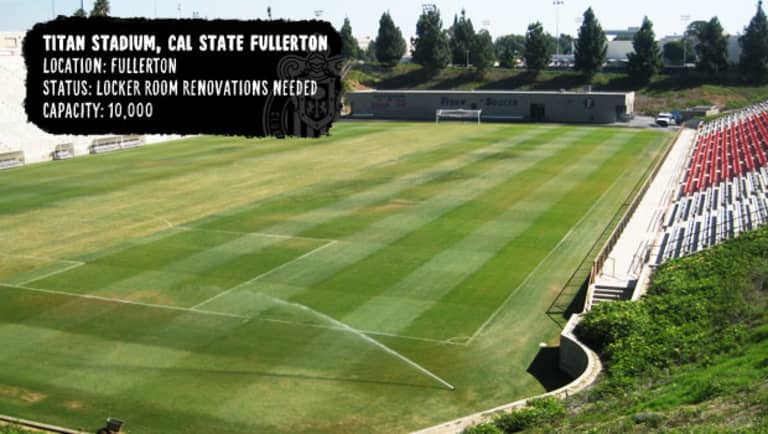
(Photo by Scott French)
---
Those dynamics exist at Cal State Fullerton, too, but Titan Stadium is the only option that could feasibly serve as a home field as is. The facility, built in 1992, seats only 10,000 and the locker rooms are not up to par, but the stadium could be expanded – and Chivas USA think it could work as a short-term solution while a permanent home was built elsewhere.
“Fullerton offers certain benefits and positive sides,” te Kloese said. “[It] has been a site for international games and games that are of impact, and that's what we're looking for.”
Chivas USA and the Galaxy have played US Open Cup matches on the grass at Titan Stadium, which also has staged US men's and women's national team games. Fullerton is convenient for fans in Orange County, southeast Los Angeles County, the eastern San Gabriel Valley and western Inland Empire.
Titan Stadium appears to be the team's most realistic short-term option at this point, according to a club source, but it's less appealing as a long-term solution. There is a substantial Hispanic population in north Orange County and the surrounding regions, but it's not particularly convenient for fans in the Mexican enclaves closer to downtown Los Angeles.
Further south, the municipally owned, 10,000-seat Santa Ana Stadium would probably have to be torn down and rebuilt to be suitable. The stadium was home to the Santa Ana Winds/Fullerton Rangers in the PDL and has been a staple for semipro games for decades, but it's unlikely any serious renovations will be made in the name of soccer.
Right now the stadium is used primarily for high school football, serving as the home field for powerhouse Mater Dei and the city's public schools. The adjacent parking structure is owned by the county, limiting revenue-sharing opportunities.
And to the east, in Pomona, the site known as Fairplex (the Los Angeles County fairgrounds) is the most curious option of the group. Pomona is at the eastern edge of the county, a barrier of sorts between the San Gabriel Valley and the Inland Empire. But there is no stadium present – there's a horse track, a dragstrip and room to build – and it's a remote locale, not at all convenient from Los Angeles.
There are other, smaller venues Chivas could peruse for short- or long-term solutions – Cerritos College in Norwalk, Veterans Stadium in Long Beach, Citrus College in Glendora, Orange Coast College in Costa Mesa, Mt. San Antonio College in Walnut, College of the Canyons in Santa Clarita – plus land in or near Irwindale, where Al Davis considered building a stadium for the NFL's Raiders a couple of decades ago, and in Riverside and San Bernardino counties, the Inland Empire.
Chivas USA arent’t looking at any of these, but they will play a friendly next Wednesday night against Veracruz at Citrus College's stadium. Maybe they'll like what they see.
Te Kloese said the hope is “that our club and franchise can be of impact in a positive way in the Los Angeles area, and we need a good house for that."
Now, however, it's about picking the right one.
“I think there are more than enough opportunities,” he said. “I think from everybody we've spoken to, we feel there is an openness to discuss opportunities to do that, but we also need to be respectful to every agreement that we have, and we need to be careful. We need to be solid in our decision-making in looking for the best option.”

